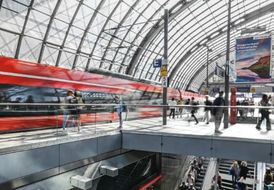Development in the year under review
- The market environment remained very positive, but became somewhat more clouded at the end of the year.
- Strong improvement in profits, particularly in air and ocean freight.
- Comprehensive measures to improve efficiency and digitalization.
DB Schenker | 2022 | 2021 | Change | 2019 | |
absolute | % | ||||
Customer satisfaction (SI) | 70 | 68 | +2 | – | 71 |
Land transport shipments (million) | 102.8 | 110.7 | –7.9 | –7.1 | 107.1 |
Air freight volume (export) (thousand t) | 1,326 | 1,438 | –112 | –7.8 | 1,186 |
Ocean freight volume (export) (thousand TEU) | 1,909 | 2,003 | –94 | –4.7 | 2,294 |
Total revenues 1) (€ million) | 27,604 | 22,939 | +4,665 | +20.3 | 17,091 |
External revenues 1) (€ million) | 27,545 | 22,853 | +4,692 | +20.5 | 17,018 |
Gross profit margin 1) ( %) | 30.9 | 31.9 | –1.0 | – | 36.1 |
EBITDA adjusted 1) (€ million) | 2,512 | 1,826 | +686 | +37.6 | 1,082 |
EBIT adjusted 1) (€ million) | 1,841 | 1,234 | +607 | +49.2 | 538 |
EBITmargin (adjusted) 1) (%) | 6.7 | 5.4 | +1.3 | – | 3.1 |
Gross capital expenditures 1) (€ million) | 946 | 842 | +104 | +12.4 | 662 |
Employees 1) as of Dec 31 (FTE) | 76,591 | 75,418 | +1,173 | +1.6 | 76,153 |
Employees 1) annual average (FTE) | 75,907 | 74,067 | +1,840 | +2.5 | 76,047 |
Employee satisfaction (SI) | 4.0 | – | – | – | – |
Share of women as of Dec 31 (%) | 36.7 | 36.5 | +0.2 | – | 36.1 |
Specific greenhouse gas emissions (land transport) compared to 2006 (based on tkm) (%) | –29.4 | –31.6 | +2.2 | – | –24.0 |
Specific CO₂ emissions (air freight) compared to 2006 (related to tkm) (%) | –16.2 | –17.4 | +1.2 | – | –9.1 |
Specific CO₂ emissions (ocean freight) compared to 2006 (based on tkm) (%) | –67.2 | –68.4 | +1.2 | – | –64.3 |
1) Figure for 2021 or as of December 31, 2021 adjusted due to the intra-Group reallocation of the FLS business area.
Customers in 30 countries were surveyed to assess customer satisfaction. The survey is carried out annually, inviting more than 200,000 participants. Customer satisfaction increased in 2022.
Volume development declined overall. The absence of catch-up effects following the Covid-19 pandemic from the previous year and the generally weak market development due, among other things, to Covid-19-related restrictions in Asia and disruptions in the supply chains could only be partially offset.
Economic development, driven by air and ocean freight, was very encouraging: operating profit figures rose very significantly in all regions. As a result, gross profit also improved noticeably (+16.7%). Adjusted for exchange rate effects, the increase was somewhat less pronounced.
Income development was very positive, driven by strong revenue growth:
- Revenues: Sharp increase as a result of higher freight rates, in particular in air and ocean freight and as a result of exchange rate effects. Demand development had a dampening effect in the opposite direction.
- Other operating income: Increase (+18.4%/€ +41 million) at a low level. The reasons for this included higher income from the release of provisions.
Expenses were driven mainly by freight-rate developments. In contrast, the effects of measures to improve productivity had a lowering effect:
- Cost of materials: Significant increase (+21.3%/€ +3,375 million) as a result of freight rate developments, particularly in air and ocean freight. Exchange rate effects also had the effect of increasing expenses.
- Personnel expenses: Increase (+12.2%/€ +447 million) due to a higher average number of employees and exchange rate effects.
- Other operating expenses: An increase (+10.9%/€ +198 million) resulted, among other things, from increased expenses for again more intensive travel activities, in connection with projects and exchange rate effects.
- Depreciation: Increase (+13.3%/€ +79 million) due to capital expenditures (including leasing). In addition, exchange rate effects had the effect of increasing expenses.
Capital expenditure activities increased. The increase was mainly due to leasing activities. The capital expenditure priorities were the Europe and Asia regions. Adjusted for exchange rate effects, the increase was even more pronounced.
The number of employees increased slightly. More complex work processes related to Covid-19 resulted in additional new hires, in particular in land transport and in air and ocean freight.
Employee satisfaction has risen slightly compared with 2020. This is due to improvements in customer focus and quality.
Specific CO₂ emissions were reduced in comparison with the reference year 2006:
- Land transport: The slight reduction in pure CO₂ efficiency is due to datasets of biofuel upstream chains updated by the Institute for Energy and Environmental Research (Institut für Energie- und Umweltforschung; ifeu).
- Air freight: Air transport once again shows a slight decline in efficiency. In comparison with the pre-Covid-19 level, however, major increases in efficiency continue to be recorded.
- Ocean freight: The efficiency of ocean freight has fallen slightly due to a slight deterioration in the efficiency of the relevant shipping companies and bottlenecks on heavily frequented trade lanes.
- Increase in international transport services more than compensated by the decline in domestic transport services.
- High freight rates drove development.
- Quality improvements with positive effects.
- Further promoting digital transformation and optimizing the product and customer mix, the network and an even more sustainable product range.
Land transport line of business | 2022 | 2021 | Change | 2019 | |
absolute | % | ||||
Land transport shipments (million) | 102.8 | 110.7 | –7.9 | –7.1 | 107.1 |
Total revenues 1) (€ million) | 7,852 | 6,952 | +900 | +12.9 | 7,125 |
External revenues 1) (€ million) | 7,832 | 6,934 | +898 | +13.0 | 7,058 |
EBITDA adjusted 1) (€ million) | 399 | 281 | +118 | +42.0 | 341 |
EBIT adjusted 1) (€ million) | 158 | 99 | +59 | +59.6 | 172 |
Employees 1) as of Dec 31 (FTE) | 24,706 | 22,668 | +2,038 | +9.0 | 21,811 |
1) Figures for 2021 or as of December 31, 2021 adjusted due to the intra-Group reallocation of the FLS business area.
In land transport, demand declined, driven by declines in parcel and system transport in particular after the previous year was marked by Covid-19-related catch-up effects. The decline in shipment figures for direct freight is largely due to the effect of the FLS transaction.
On the other hand, the economic development was very encouraging: the operating profit figures developed positively as a result of a disproportionate increase in income:
- Revenues: Increase due in particular to generally higher sales prices. Demand development had a dampening effect in the opposite direction. Adjusted for exchange rate effects, the increase was even more pronounced.
- Other operating income: Decline due, among other things, to lower income from the disposal of property, plant and equipment.
Developments on the expenses side were characterized by more cost-intensive processes in the areas of direct, system and special transport due to the Covid-19 pandemic. Compared with income, however, the increase was disproportionately low:
- Cost of materials: Slight increase, in particular higher prices and negative exchange rate effects were partially offset by declines in demand.
- Personnel expenses: Increase due to a higher number of employees.
- Other operating expenses: Increase due to reclassification of IT expenses within the business unit.
The number of employees increased significantly, due in part to the acquisition of USA Truck.
- Declines in demand in air freight due to weak market momentum.
- Capacity shortages and Covid-19-related uncertainties continue to shape development, in particular in ocean freight.
- Freight rates continued to be at a high level; significant weakening again at the end of the year.
Air and ocean freight line of business | 2022 | 2021 | Change | 2019 | |
absolute | % | ||||
Air freight volume (export) (thousand t) | 1,326 | 1,438 | –112 | –7.8 | 1,186 |
Ocean freight volume (export) (thousand TEU) | 1,909 | 2,003 | –94 | –4.7 | 2,294 |
Total revenues (€ million) | 16,530 | 12,963 | +3,567 | +27.5 | 7,218 |
External revenues (€ million) | 16,521 | 12,957 | +3,564 | +27.5 | 7,213 |
EBITDA adjusted (€ million) | 1,575 | 1,094 | +481 | +44.0 | 342 |
EBIT adjusted (€ million) | 1,503 | 1,028 | +475 | +46.2 | 287 |
Employees as of Dec 31 (FTE) | 14,204 | 13,609 | +595 | +4.4 | 13,964 |
Performance development declined:
- Air freight: Negative effects, mainly due to the war in Ukraine and the lockdowns in China, were not able to be compensated for.
- Ocean freight: As a result of market developments, volumes were also slightly below the previous year’s low level. Equipment and capacity shortages, alongside the tense market situation (especially in China) due to Covid-19, were only partially offset by volume growth on transpacific routes and between Asia and Europe.
On the other hand, the economic development was very encouraging: the operating profit figures improved due to the significant increase in income:
- Revenue: Significant increase, mainly due to the development of freight rates. Performance development had a dampening effect. In air freight, the trends of the previous year were boosted by capacity-limiting measures (in particular airspace closures and sanctions). At the end of 2022, however, rising capacity and lower demand led to a decline in freight rates, making it difficult to pass on higher prices to customers in some cases. Scarce capacity and high demand also led to significantly higher freight rates in ocean freight. At the end of 2022, however, freight rates were almost back to pre-Covid-19 levels as a result of declines in demand. Adjusted for exchange rates, the increase in revenues was weaker.
- Other operating income: Increase at a low level, partly as a result of higher effects from the release of provisions.
On the expenses side, the development of freight rates was particularly noticeable:
- Cost of materials: Increase mainly as a result of freight rate developments and due to exchange rates.
- Other operating expenses: Increase due to reclassification of IT expenses within the business unit.
- Personnel expenses: Personnel expenses increased as a result of a higher number of employees, partly due to performance-related factors, and also as a result of exchange rate effects.
The number of employees rose. More complex work processes brought about by Covid-19 resulted in additional new hires.
- New business performed better than expected, particularly in Asia/Pacific and America.
- Measures to improve productivity and profitability are currently being implemented.
Contract logistics line of business | 2022 | 2021 | Change | 2019 | |
absolute | % | ||||
Warehouse space (million m²) | 8.6 | 8.4 | +0.2 | +2.4 | 8.4 |
Total revenues (€ million) | 3,195 | 2,965 | +230 | +7.8 | 2,734 |
External revenues (€ million) | 3,193 | 2,963 | +230 | +7.8 | 2,733 |
EBITDA adjusted (€ million) | 455 | 372 | +83 | +22.3 | 312 |
EBIT adjusted (€ million) | 166 | 107 | +59 | +55.1 | 79 |
Employees as of Dec 31 (FTE) | 22,101 | 24,056 | –1,955 | –8.1 | 24,625 |
The development in contract logistics followed the overall market thanks to its diversified portfolio that covers different geographic regions and market sectors. Development in Europe was positive despite restructuring measures and influences from the war in Ukraine.
The economic development was very encouraging in a challenging market environment: the operating profit figures rose, driven by above-average income gains in particular:
- Revenue: Sharp increase, driven by a continuing recovery after Covid-19 restrictions. Revenue development is due in particular to new business and additional volume in the Asia/Pacific and Europe regions. The electronics and consumer sectors in particular developed positively. Adjusted for exchange rate effects, the increase was less pronounced.
- Other operating income: Increase due in part to reversals from provisions at a low level.
In terms of expenses, the recovery in demand was noticeable:
- Personnel expenses: Increase as a result of business development. Exchange rate effects also had the effect of increasing expenses.
- Other operating expenses: This increase is due, among other things, to higher costs for temporary workers as a result of the increased business development, as well as higher IT expenses and energy costs. Exchange rate effects also had the effect of increasing expenses.
- Depreciation: Depreciation increased significantly as a result of the conclusion of lease contracts for storage capacity.
The development of the cost of materials partially offset this impact:
- Cost of materials: Decrease due to lower operating costs for the maintenance of warehouses. However, the performance-related increase in expenses for purchased freight forwarding services had a partially compensating effect. Adjusted for exchange rates, the decline was significantly higher.
The number of employees fell slightly, due in part to higher productivity and a tense labor market.


